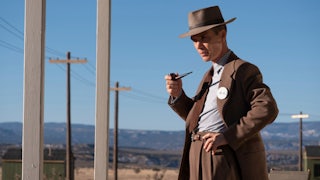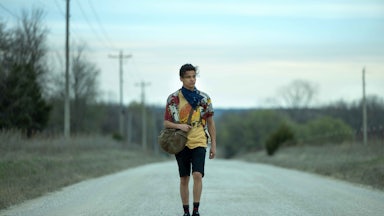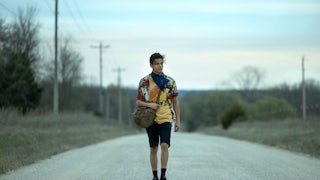The United States was born in settler-colonialism; the story of America’s formation is one of the descendants of Europeans spreading out across a continent, murdering and expelling Indigenous peoples everywhere they go. Hollywood has recounted this story from its earliest days via a genre, the Western, that has traditionally cast Anglo-American cowboys as the vanguard of civilization, inexorably advancing against hostile, one-dimensional, and crudely stereotyped Indians. And despite protests against that portrayal over many decades, as well as recent attempts to capture fully realized Indigenous communities on camera, popular culture still rarely confronts audiences with the depths of this foundational American evil.
Killers of the Flower Moon, Martin Scorsese’s new big-budget film based on David Grann’s acclaimed 2017 book, is, among other things, a monumental exception. Set in Osage County, Oklahoma, during the 1910s and ’20s, it offers one of the most vivid and unnerving accounts of what settler-colonialism actually means in practice, closely dramatizing a series of real events that Grann both drew attention to and helped further uncover.
The events in question almost defy belief. In the late nineteenth century, the small Osage tribe settled in a barren part of Oklahoma (then considered Indian Territory) after having been driven from more fertile lands in a series of other U.S. states. There they discovered some of the largest known oil reserves in the country, on lands federally recognized as their own, and within two decades the Osage had become some of the wealthiest people per capita on earth. Each member of the tribe was entitled from birth to a share of a vast fortune, in total equivalent to hundreds of millions of today’s dollars, and the Osage became subjects of national fascination for their lavish spending on clothes, cars, private schools, and hired servants and chauffeurs—the latter often white. White cattle ranchers, oilmen, fortune-seekers, and assorted ne’er-do-wells flocked to the Osage oil towns in search of employment. In a stunning inversion of how America typically imagines the culture of the frontier, that employment often consisted of performing menial labor for conspicuously wealthy Indians.
The inversion didn’t last. Beginning in 1918 and continuing for over a decade, dozens of Osage died under mysterious circumstances. Some of these deaths appeared to be of natural causes, while others were clearly murders; the largely ad hoc local law enforcement showed little interest in investigating, either way. Mollie Burkhart, a full-blood Osage woman married to her white former chauffeur, Ernest Burkhart, took matters into her own hands by traveling to Washington D.C. to request the involvement of the Bureau of Indian Affairs, and ultimately of a brand-new federal law enforcement agency that would become the FBI. What the federal investigation uncovered was horrific and macabre: Far from a series of one-offs, the Osage murders (and they were all murders) were orchestrated systematically by local white elites, in particular William Hale, Ernest Burkhart’s uncle and the self-proclaimed “King of the Osage,” in an elaborate conspiracy to marry into Osage families, exterminate their heirs, and transfer their oil wealth to whites. Hale was sentenced to life in prison but ultimately only served 18 years and died a free man; it would take the Osage until 2011, nearly a century after the murders, to finally settle with the federal government for something approaching the scale of the fortune plundered from them.
It’s a sordid and incredible story, and it makes for a great book. The movie adaptation more than vindicates Scorsese’s ongoing defense of the potential of cinema as art against the schlocky commercial franchises that have dominated Hollywood for the past decade. At nearly three and a half hours, Scorsese’s Flower Moon is a lot to take in, but it offers an unforgettable immersion in a time and place in American history that few Americans are familiar with. It does so, moreover, by drawing on themes that span Scorsese’s long and accomplished career. As in Gangs of New York, here is American history like we’ve never seen it; as in Silence, here is a violent encounter between radically different cultures fully realized in dignity and complexity; as in Goodfellas or Casino, here is a mob movie (Hale, portrayed by longtime mob movie star and Scorsese collaborator Robert De Niro, is running what amounts to a Mafia outfit); as in The Wolf of Wall Street or The Departed, here’s a story of a group of men getting away with shocking crimes until federal agents intervene and turn them against each other like captive rats. Scorsese, in short, has made a film that is both unmistakably his and a benchmark in how popular culture understands the American West and the Indigenous experience.
The world Scorsese recreates is an Old West in its twilight. Ford Model Ts cruise down muddy unpaved streets lined with Prohibition-era speakeasies; scores of primitive oil derricks tower over untamed rural fields; the Osage decorate their handsome roaring-twenties homes with traditional blankets; the informal, almost anarchic justice system of a frontier town is unprepared for the ruthless efficiency of the proto-FBI. The era of the Wild West is passing; oil, the automobiles it powers, and the immense fortunes it generates are the West’s emergent future.
Our entry point to this world is the unsophisticated, unimaginative Ernest (Leonardo DiCaprio), who arrives in Osage County fresh from the trenches of Europe and looking for work. His uncle William Hale (De Niro) is a sort of community elder among the area’s whites; he has learned the Osage language and formed close ties with leading Osage families. From the beginning, Hale encourages Ernest to marry an Osage woman and makes clear that the end goal is to consolidate white control of Osage oil claims. As transparently mercenary as this seems, Ernest approaches his assignment with a kind of disaffected naïveté. As he courts Mollie (a phenomenal Lily Gladstone, the most prominent among many Indigenous actors given star turns in Flower Moon), it’s possible to believe his affections for her are at least partly genuine. Mollie is no fool; she sees clearly enough that Ernest is attracted to her wealth, but at the same time she finds him charming and they have an awkward sort of chemistry. The idea that Ernest’s courtship is entirely cynical is unsettling; that he might be capable of murderous violence against members of his new Osage family is incomprehensible. Even as we know where this is headed, our instinct is to resist that conclusion.
The murders have already begun when we first arrive in Osage County, but they haven’t yet reached epidemic proportions. Scorsese takes the time to acquaint us with the religious beliefs and customs of the Osage, the interpersonal dynamics of Mollie’s family, and the teeming streets of Fairfax, the boomtown where much of the action takes place. He wants us to get to know this world before we see it torn apart by the intimate violence of Hale’s mob. We see, for instance, Ernest and Mollie’s traditional Osage wedding ceremony, conducted largely in the Osage language, and for a moment it’s tempting to believe that whites and Osage can peacefully coexist on terms of mutual respect.
Scorsese extensively researched and consulted with the Osage to ensure an accurate and three-dimensional portrayal of their society. Those efforts are on full display, but some (including the film’s Osage translator) may protest that the story nonetheless centers on white men committing heinous acts. Those complaints aren’t baseless, but Scorsese ultimately justifies this framing: He casts some of the leading white male actors in Hollywood as what amounts to an invasive species, devouring and destroying everything in their paths out of the most venal motives. This isn’t limited to the leads, either; bit by bit, we see how every part of white society in Fairfax is complicit in Hale’s plot, from the appointed white legal guardians whom full-blooded Osage like Mollie are required to beg for the right to access their own wealth, to the town doctors who conspire to poison Mollie via her insulin shots. The least sinister white character is Tom White (Jesse Plemons), the federal agent who ultimately holds Hale’s ring to account, but while he is admirably competent, there’s no sense that he’s doing anything more than his job on behalf of a briefly name-checked ambitious young bureaucrat—one J. Edgar Hoover. He can lock up a few of the most egregious offenders in the name of an advancing federal leviathan, but he’s not there to save the Osage.
There’s no vanity in De Niro’s or DiCaprio’s performance; they are loathsome, petty, and thoroughly unworthy of the people whose trust they are betraying. A memorable and morbidly funny scene in a Masonic lodge has De Niro punishing DiCaprio for an ill-considered insurance scam by bending him over an altar and brutally spanking him with a wooden plank. It’s simultaneously abusive and undignified. Men like this, Scorsese seems to be saying, created the paved-over and petit-bourgeois country we now live in.
The penultimate sequence of Flower Moon takes place in the more familiar world they built. We see a stage studded with white voice actors, some decades after the film’s main events. They are taping a radio show, sponsored by Hoover’s FBI and by Lucky Strike cigarettes, that tells of the agency’s supposed great triumph in solving the case; it’s essentially a midcentury precursor to today’s true crime podcasts. Through a broadcaster played by Scorsese himself, accompanied by comical reenactments and sound effects, we learn about the ultimate fates of Ernest, Mollie, Hale, and the other characters we’ve gotten to know. It becomes clear that, although the FBI is touting its own success, only limited justice was done, and that Hale’s recurrent Old Testament–style prophecy that whites would sweep the Osage aside in the name of progress effectively came to pass.
But Flower Moon doesn’t end on that note. It ends, instead, with a stunning aerial overhead shot of today’s Osage assembling in ritual formations. In spite of all the murder and plunder and betrayal, the Osage still endure. Settler-colonialism can be relentless and cruel and seemingly hegemonic, but its triumph is never total; to survive it is to resist it. It’s a timely lesson.






